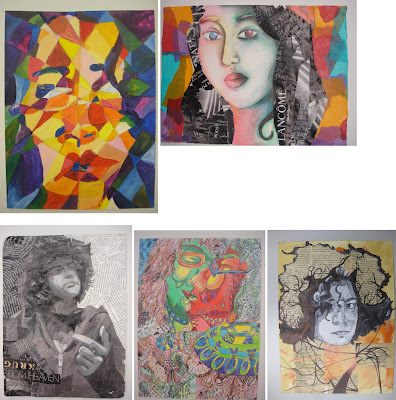Create two mixed-media portraits on Bristol board. Think about the theme of your persona or your subject's persona and style in how you will approach the project. This is not about traditional portraiture, it's an interpretation as well, it's your original, unique vision, but it gives you the freedom to find creative solutions to the traditional portrait. think abstract, deconstruction, mixed media, collaging, material, overlapping and weaving in your elements in creating a strong compositional solution. You must find a way to integratae all the elements of your materials.
One self-portrait, and one portrait of a friend or family member. Through the process, you will begin to explore additive technique in two-dimensional art. In particular, you will experiment with integrating collaging with traditional painting and drawing techniques. MUST BE VISUALLY PLEASING (good aesthetics please). Think and analyze your process, method of execution and explore creative solutions. Be experimental.
Attention will be given to the design principles we covered first semester. Namely: (framing, Scale, Hierarchy, F/G relationship, balance, composition, value, contrast and color theory/relationships). All that we have studied thus far is crucial in creating a cohesive unified solution. How will everything tie in together to create a balanced composition.
This project is treated as an abstraction and interpretive. not to be literal. All elements must work together to create a cohesive (unified), resolved, and finished work. Really think about your approach as in theme, style, be selective with materials and how to work them into your composition. Integrate the materials thinking of overlapping, layering, creating transparency in your finished piece. That can be done with different methods of layering mediums. You really need to analyze your piece and be visually aware of your AESTHETICS.
This project is treated as an abstraction and interpretive. not to be literal. All elements must work together to create a cohesive (unified), resolved, and finished work. Really think about your approach as in theme, style, be selective with materials and how to work them into your composition. Integrate the materials thinking of overlapping, layering, creating transparency in your finished piece. That can be done with different methods of layering mediums. You really need to analyze your piece and be visually aware of your AESTHETICS.
Due Dates (Critiques)
Mon/Wed Class: Wed, April 6th.
Tues/Thurs Class: Thurs, April 7th. Rubric
You will be assessed on your application of the design principles mentioned above, your craftsmanship, and your creativity.
Materials
- Two Sheets of Bristol board 13in. x 10in.
- Paint, markers, colored pencils, charcoal, watercolors, etc.
- Fabric scraps, tissue paper, magazine cutouts, string, yarn, newspaper, etc.
- Appropriate adhesive (white glue, rubber cement, gel medium)
Process
Step 1
In your sketchbook, create 5 different contours (silhouettes) that you will use as a reference for your collage.
Begin by drawing yourself with a mirror. Pay close attention to details, such as facial features, and their relative size and position to one another. Be sure to map all these elements out correctly. Use cropping and position on paper to create a dynamic composition.
Draw a silhouette of the head, then include neck and shoulders, add hair, include ears... Think about what you could add/remove to make it unique (pencil behind ear, sunglasses in hair, specific earring, etc)
Process to consider when creating your mixed media composition. Think abstract. Think creative. deconstruct. think of creating focal areas and how your eye travels through the piece.
Process to consider when creating your mixed media composition. Think abstract. Think creative. deconstruct. think of creating focal areas and how your eye travels through the piece.
Step 2
Focus on other areas of your body- hands, feet, legs, and entire figure. Repeat the steps above, to create 5 more contours from these observational drawings.
Step 3
Tape the compositions to a wall, take a step back, and examine at your contours. Examine the positive/negative space, and composition, of each contour. Which are most successful?
Now, look at the compositions alongside each other. Pay attention to the different ways the compositions interact with each other. Do they work as a pair? Are there similarities? Do they have elements that crossover? How do they inform (relate and influence) each other? What combinations of compositions are particularly successful? Of course they are not the same but they have similar styles that communicate to make them a pair.
You must Find ways to make the composition stronger, by overlapping, intersecting, combining, cutting, cropping, etc. Continue to refine the composition by rearranging, adding, and deleting elements.
Step 4
Explore with different materials (paint, collage, markers, fabric, metal, etc), continuing to refine the composition. Use color, texture, and value to tie everything together.
NOTE: THIS IS NOT A 3-D PROJECT; KEEP THE WORK 2-D.It can have lots of texture, and some depth, but the bristol board must be able to physically support all the materials you have incorporated.
Research the terms: Assemblage, Mixed-Media, Collage. below are other references.
Art-Historical Examples
Pablo Picasso






No comments:
Post a Comment